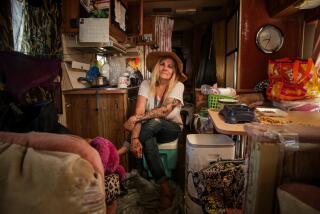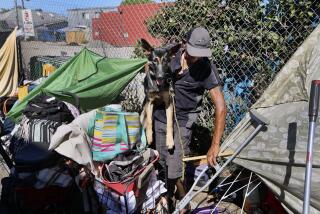‘Urban Campground’ Draws Only a Few Homeless on Opening Day
- Share via
‘I think it’s going to take a few days before people feel this is a place to go.’
--Lt. Col. David Riley, Salvation Army division commander
The City of Los Angeles opened its first “urban campground” for the homeless Monday but drew only a handful of people.
The first homeless person to enter the gate in the chain-link fence surrounding the 12-acre site at 320 S. Santa Fe Ave. was 25-year-old David Norrington, a husky, blue-eyed, young man who said he wanted to help Justiceville--the homeless activist group--set up an enclave within the camp.
“I’m not a good example of homeless,” Norrington said shortly before noon, after undergoing a weapons search by uniformed security guards hired by the city, “because I’m a rover.”
He has been without an address since 1982.
“I find it pleasing to travel,” he said.
The camp, planned by the city to house 600 or more homeless people for two months, sits land owned by the Southern California Rapid Transit District.
By 9 p.m. Monday, about 60 homeless people, including six children, had moved into the camp and received an evening meal of beef stew, rice and salad, some of them returning for second helpings and one for a third.
“I think it’s going to take a few days before people feel this is a place to go,” said Lt. Col. David Riley, Southern California division commander for the Salvation Army, which is operating the campground for the city.
The camp, on a desolate strip of land beside the Los Angeles River, contains a white trailer for administration, a brown trailer containing 10 showers and several wooden picnic-style tables for the free dinners served at 7:30 nightly.
Fourteen yellow-and-white canopies, much like those used at garden parties, are being used as tents. The coverings lack side flaps to protect campers from the wind and night air, but the Salvation Army said it will provide blankets.
City workers watered the campground down with hoses several times Monday in a vain attempt to keep down the dust kicked up by the wind.
A variety of social service agencies have agreed to come to the campground, city officials said, including the Los Angeles County Department of Public Social Services and other health, family and legal services. None was in evidence Monday, however.
Mayor Tom Bradley inspected the camp, calling it “an emergency response to a serious problem.”
“We will continue to look for permanent solutions,” he said.
Bradley had proposed the camp 12 days earlier as a temporary housing alternative for those living in Skid Row sidewalk encampments.
The operating guidelines of the camp were outlined in a “procedural accord” worked out by city officials, the Salvation Army and representatives of the homeless community. The agreement bars weapons and alcohol but allows campers to choose where they will sleep and to come and go as they please.
Knives Confiscated
Salvation Army staff members took two large knives away from two homeless campers, who said they used them only for cutting food.
A few members of Justiceville moved onto the campground Monday. But Adam Bennion, leader of another activist group, the Los Angeles Union of the Homeless, said his group had not yet decided to relocate from under the 4th Street Bridge.
He was unhappy that the city had not chosen his members to provide the camp’s paid security service. He said they were also unwilling to move under the canopies and will wait until they all had their own tents to protect them from the wind.
But Herbert Lee Akridge, 34, and his wife, Carla, said they were happy to move in.
“If we can stay here for 60 days,” Akridge said, “that should give us time to get some things together. We’re kind of in a hurry. . . .”
Find a Job
His wife, he explained, is seven months pregnant, and “we’d like to have a job and somewhere more permanent to stay before the baby’s born.”.
Neal and Christine Frye and their 5-year-old son, Eric, were glad to move in too.
Frye said he had brought his family to Los Angeles from their former home in Maryland to take a plumbing job that was offered by telephone. But by the time they arrived, the job had been filled.
“We been selling blood, my wife and I . . . and getting food from the wagons that come around.
“Now maybe we can get a little ahead. Maybe even get a job before they close this place down.”
Before the camp was opened about 80 protesters gathered across the street, carrying black streamers and large painted murals, one of which labeled the camp “Soweto, USA.”
City Blamed for Problem
The protesters, who included workers from local social service agencies, clergymen and other private citizens, said the city had helped create a homeless problem by not doing enough to preserve Skid Row’s low-income housing.
“The issue is housing. It’s not homelessness, it’s not encampments, it’s redevelopment. Housing versus redevelopment,” said Jeff Dietrich, a member of the Catholic Worker, which runs a soup kitchen on Skid Row.
Not everyone had heard of the camp or knew it was open.
“Didn’t know it would be open so soon,” said Edward Boyd, 55, who was standing on a street corner downtown. “I don’t think a lot of the people knew.”
And not everyone cared.
David Smith, 31, a recent arrival from Philadelphia, said he had seen the place Sunday and was not impressed.
“Fences, gates and guards,” he said. “I know a concentration camp when I see one. I’m staying right here on the street.”
More to Read
Sign up for Essential California
The most important California stories and recommendations in your inbox every morning.
You may occasionally receive promotional content from the Los Angeles Times.










